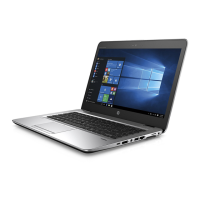
Do you have a question about the HP mt43 and is the answer not in the manual?
| Form factor | Clamshell |
|---|---|
| Product type | Mobile thin client |
| Product color | Silver |
| Country of origin | China |
| Panel type | SVA |
| LED backlight | Yes |
| Display diagonal | 14 \ |
| Native aspect ratio | 16:9 |
| Keyboard layout | QWERTY |
| Pointing device | Touchpad |
| Processor cache | 2 MB |
| Processor cores | 4 |
| Processor model | PRO A8-9600B |
| Processor family | AMD PRO A8 |
| Processor frequency | 2.4 GHz |
| Processor cache type | L2 |
| Processor manufacturer | AMD |
| Processor boost frequency | 3.3 GHz |
| Memory slots | 2x SO-DIMM |
| Internal memory | 8 GB |
| Memory clock speed | 2133 MHz |
| Internal memory type | DDR4-SDRAM |
| Memory layout (slots x size) | 2 x 4 GB |
| SSD capacity | The Solid State Drive's storage capacity in Gigabytes. |
| SSD interface | SATA |
| Storage media | SSD |
| SSD form factor | M.2 |
| Total storage capacity | 128 GB |
| Compatible memory cards | SD |
| Number of SSDs installed | 1 |
| Discrete graphics card model | Not available |
| On-board graphics card model | AMD Radeon R5 |
| Speakers manufacturer | Bang & Olufsen |
| Number of built-in speakers | 2 |
| Front camera signal format | 720p |
| Battery capacity | 51 Wh |
| Number of battery cells | 3 |
| AC adapter power | 45 W |
| Wi-Fi standards | 802.11a, Wi-Fi 5 (802.11ac), 802.11b, 802.11g, Wi-Fi 4 (802.11n) |
| Bluetooth version | 4.2 |
| Ethernet LAN data rates | 10, 100, 1000 Mbit/s |
| Charging port type | DC-in jack |
| USB 2.0 ports quantity | 0 |
| Sustainability certificates | ENERGY STAR |
| Operating system installed | Windows 10 IoT Enterprise |
| Operating system architecture | 64-bit |
| Depth | 226 mm |
|---|---|
| Width | 338 mm |
| Height | 18.9 mm |
| Weight | 1480 g |
Important notice regarding customer self-repair parts and potential warranty voiding.
Warning about potential heat-related injuries or device overheating.
Identifies ports and connectors on the right side of the device.
Identifies ports and connectors on the left side of the device.
Describes components located on the display, such as antennas and webcam.
Details the touchpad and pointing stick functions.
Explains the status and meaning of various device indicator lights.
Describes the power button, speakers, and volume controls.
Explains the purpose of various keys on the keyboard.
Provides instructions on using function key combinations for system functions.
Identifies docking connectors and cooling vents on the bottom of the device.
Describes the status lights on the front of the device.
Explains the purpose and location of service and regulatory labels.
Lists the main internal and external parts of the computer.
Details the parts that make up the display assembly.
Lists various plastic parts and their spare numbers.
Lists cables and their spare part numbers.
Lists various other spare parts like AC adapters and power cords.
Lists necessary tools for component replacement.
Covers ESD damage and grounding procedures.
Introduces procedures for user-replaceable parts.
Details steps to remove and replace the bottom cover.
Provides instructions for removing and replacing the battery.
Explains how to remove and replace the SSD.
Details the procedure for removing and installing memory modules.
Describes how to remove the WLAN/Bluetooth card.
Explains how to remove and replace the WWAN module.
Details the procedure for removing the Real-Time Clock battery.
Explains how to remove and replace the keyboard.
Introduces procedures for parts only accessible by authorized providers.
Details steps for removing the internal base plate.
Explains how to remove the heat sink and fan.
Details the procedure for removing the touchpad board.
Explains how to remove the smart card reader board.
Details the procedure for removing the USB/audio board.
Explains how to remove and replace the system board.
Details the procedure for removing the speaker assembly.
Explains how to remove the display assembly.
Details the procedure for removing the power button board.
Explains how to remove the top cover.
Describes the status and meaning of power and IDE LEDs.
Explains Wake-on-LAN settings and the power-on boot process.
Covers resetting BIOS passwords and power-on diagnostic tests.
Explains diagnostic codes indicated by LEDs and sounds.
Lists error codes and messages encountered during POST.
Provides general troubleshooting steps for operating problems.
Specific troubleshooting for units without ATA Flash capability.
Instructions for setting up a PXE server for network booting.
Introduces HP ThinUpdate for backup and recovery.
Explains HP Device Manager for thin client management.
Details dimensions, weight, power, and environmental specs.
Provides detailed specs for the display and SSD.
Outlines general requirements for power cords.
Lists country-specific power cord requirements.
Guides on restoring nonvolatile memory in current BIOS versions.
Guides on restoring nonvolatile memory in legacy BIOS versions.
Explains how different memory types are used and protected.
Addresses common questions about memory and BIOS.